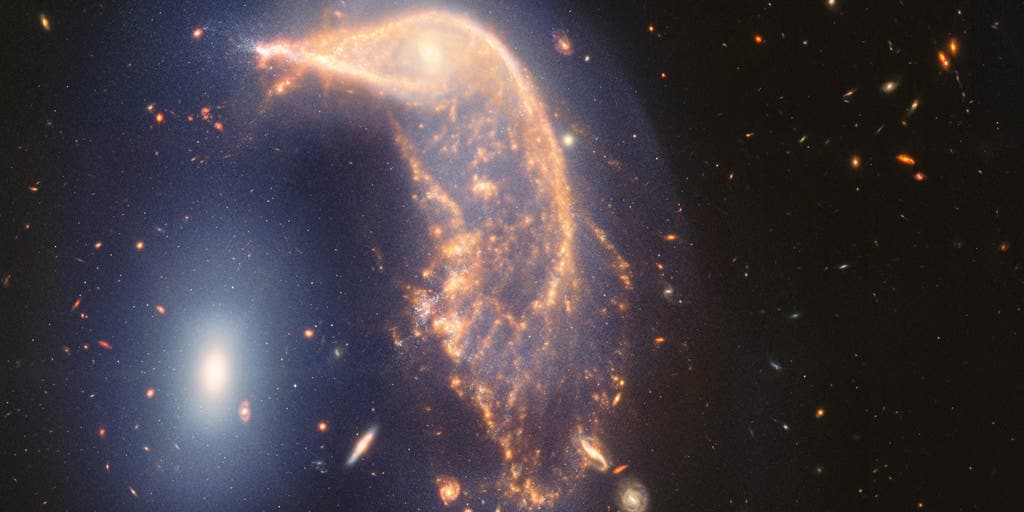What is the James Webb Space Telescope?
According to NASA, JWST will observe the universe using infrared light, a type of light that is detected as heat and is invisible to the human eye.
A photograph showing two galaxies locked in a slow “cosmic dance” is the latest wonder from the James Webb Telescope.
National Aeronautics and Space Administration (NASA) The image was released on Friday to mark Webb’s second anniversary. Astronomer It’s also popular with stargazers due to its ability to capture crystal clear images of some of the universe’s most distant secrets.
The two galaxies, known as Arp 142, are located about 326 million light-years from Earth. The two galaxies first mingled sometime between 25 and 75 million years ago, when the “penguin” shaped galaxy (known as NGC 2935) and the more compact “egg” galaxy (NGC 2937) passed each other for the first time, beginning a complex gravitational dance.
These images of Arp 142 are a composite of separate exposures taken by the James Webb Space Telescope using its NIRCam and MIRI instruments. (NASA, ESA, CSA, STScI/NASA)
“They will continue to swing around, complete a few more loops, and merge into a single galaxy in a few hundred million years.” NASA’s Webb Mission Team wrote:.
Who Was James Webb? The Man the Space Telescope Was Named After
Before the two galaxies collided, the “Penguin” galaxy had a more traditional spiral shape, but now its center has narrowed like a penguin’s eye, and parts of the galaxy have unraveled and fanned out, giving it the penguin-like shape that Webb sees today, NASA astronomers say.
The “cosmic dance” between the two galaxies marks the second anniversary of the James Webb Telescope’s operation.
This video tours Arp 142, a pair of interacting galaxies nicknamed the Penguin and the Egg, located 326 million light-years from Earth. (Video courtesy of NASA)
“The galactic ‘dance’ gravitationally tugged at thin layers of gas and dust from the Penguin Galaxy, causing them to collide in waves and form stars,” NASA writes.
“Egg” galaxies, on the other hand, are elliptical galaxies filled with older stars, so they remain closer to their original shape with much less gas and dust to pull apart and distort, NASA said.
Galaxy Arp 142 is shown from both the Hubble Telescope (left) and the James Webb Telescope (right). (NASA)
The mass of the “egg” is also almost the same as that of the “Penguin” galaxy, which is another reason why the egg shape was not swallowed by the Penguin galaxy.
Incredible Images and Discoveries Coming from the James Webb Space Telescope in 2023
According to NASA, the two galaxies are about 100,000 light-years apart, which is very close in astronomical terms. For reference, NASA said the closest galaxy to our Milky Way is the Andromeda Galaxy, which is about 2.5 million light-years away.
One day, far-flung observers may see our galaxy make its way onto the astronomy dance floor. The Milky Way and Andromeda are expected to eventually meet, but that’s about four billion years from now. (If you can’t wait that long, check out NASA’s Here’s a handy video visualizing the dance of the future.


